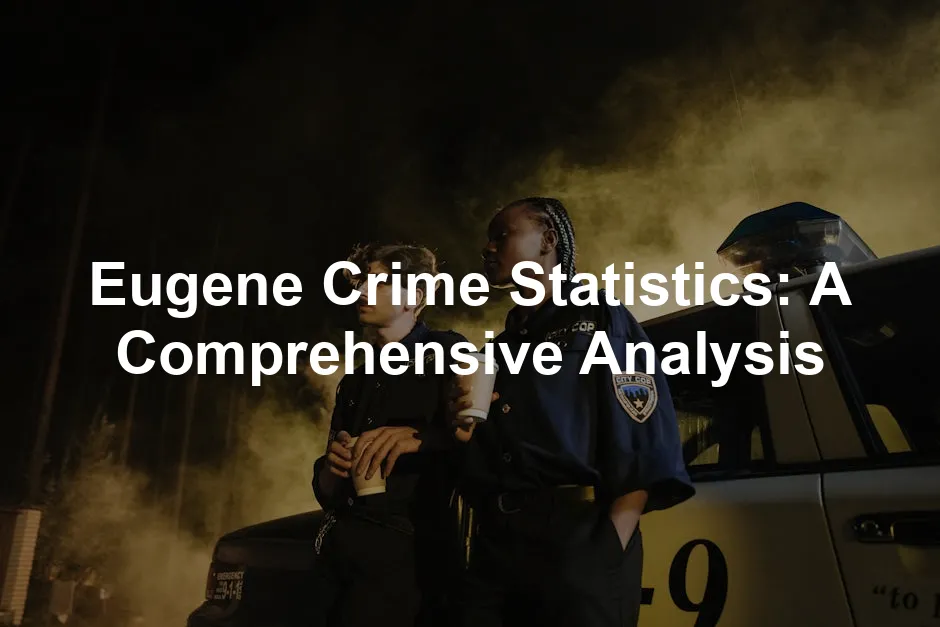Introduction
Crime statistics are crucial for understanding the safety of any city, and Eugene, Oregon, is no exception. For residents, potential movers, and researchers alike, these statistics reveal much about community dynamics and public safety. They help individuals gauge the effectiveness of law enforcement, assess neighborhood safety, and make informed decisions about living or visiting the city.
This article aims to provide a thorough analysis of crime statistics in Eugene. We will explore trends, comparisons, and public perception to paint a comprehensive picture of the city’s crime landscape.
Finding the right balance between community safety and crime rates can feel like a high-stakes balancing act in urban settings. While Eugene boasts a vibrant culture and beautiful scenery, understanding its crime rates is essential. After all, no one wants to feel like they’re living in a scene from a crime drama—unless it’s a well-scripted one, of course! So, let’s get started on this informative journey through Eugene’s crime statistics.
And speaking of safety, if you’re looking for a way to keep your home secure, consider investing in a Home Security Camera. These handy devices not only provide peace of mind but can also help deter potential intruders. Why not make your home a fortress while you enjoy the charm of Eugene?

Overview of Eugene Crime Statistics
Historical Context
Eugene’s crime statistics have evolved significantly over the years, especially with the transition from the Uniform Crime Reporting (UCR) to the Oregon National Incident-Based Reporting System (NIBRS) in 2013. This change allows for more detailed data collection, capturing multiple offenses per incident. Consequently, it is essential to regard the years 2014-2016 as baseline years for accurate comparisons. This transition has made a substantial impact on how we analyze crime trends and understand the city’s safety.
Historically, Eugene has experienced fluctuations in crime rates. For instance, the violent crime rate in 2014 was notably higher than in previous years, which sparked discussions about safety across the community. The latest trends indicate that while some crime categories have decreased, others, particularly property crimes, remain a concern for residents.
To enhance your understanding of the changing dynamics of safety, consider picking up a copy of Crime and Public Policy. This book dives deep into how crime trends affect policy decisions and community safety.

Current Crime Rates
As of the latest reports, Eugene’s crime rates reveal a mix of challenges and improvements. The violent crime rate in Eugene stands at 23.9 incidents per 100,000 people, slightly above the national average of 22.7. However, property crime rates tell a different story, with Eugene clocking in at 57.8 per 100,000, significantly higher than the national average of 35.4.
Breaking it down further, the statistics show that property crimes such as burglary, theft, and motor vehicle theft are prevalent. Notably, theft accounts for the majority of property crime incidents in the city. Despite these challenges, Eugene remains a desirable place to live, with its community spirit and picturesque surroundings providing a buffer against the negative aspects of urban life.
If you’re looking to enhance your home security against potential theft, why not check out a Smart Lock? They allow you to control access to your home right from your smartphone, making it easier to keep intruders out while you enjoy life in Eugene.
When comparing Eugene’s crime rates to state and national averages, it’s clear that the city faces unique challenges. While violent crime rates are relatively close to national figures, property crime rates are significantly elevated. This discrepancy raises questions about community safety and law enforcement effectiveness in addressing these issues.
In summary, Eugene’s crime statistics present a complex picture. Understanding these figures is essential for residents and potential movers alike. The balance between enjoying the city’s charm and being aware of its safety dynamics can make all the difference in life in Eugene.

Detailed Breakdown of Crime Rates
Violent Crime
Types of Violent Crimes
Eugene has its share of violent crime, which isn’t exactly what you’d call a charming aspect of the city. The statistics for violent crimes have been fluctuating over the past decade. Let’s break down the main types of violent crimes: murder, rape, robbery, and assault.
1. Murder: Eugene has reported a murder rate of about 1.7 incidents per 100,000 residents, which is lower than the national average of 6.1. However, every life lost is significant, so it’s crucial to keep an eye on this statistic.
2. Rape: This crime is more prevalent, with the rate in Eugene sitting at 70.7 incidents per 100,000. This is notably higher than the national average of 40.7, suggesting that this is an area needing attention and resources.
3. Robbery: The robbery rate here is 75.3 per 100,000, which is significantly lower than the national average of 135.5. While this seems promising, every robbery still has a story behind it, and community efforts should focus on prevention.
4. Assault: Assaults in Eugene occur at a rate of 229.8 per 100,000, which is below the national average of 282.7. This number reflects the efforts of law enforcement and community engagement to keep the streets safer. For more insights on this issue, you can check the campus sexual assault statistics which provide a broader context on violence.

Understanding the context of assault statistics is essential for grasping the safety dynamics in urban settings. Read more about this topic here.
To visualize these trends, consider the following graph depicting violent crime rates from 2014 to 2023:
| Year | Murder | Rape | Robbery | Assault |
|---|---|---|---|---|
| 2014 | 2.0 | 79.0 | 85.0 | 336.0 |
| 2015 | 3.0 | 88.0 | 80.0 | 286.0 |
| 2016 | 5.0 | 99.0 | 83.0 | 364.0 |
| 2017 | 1.8 | 60.0 | 105.0 | 374.0 |
| 2018 | 1.8 | 69.7 | 100.0 | 368.0 |
| 2019 | 1.2 | 71.0 | 103.9 | 373.0 |
| 2020 | 2.0 | 114.0 | 162.0 | 413.0 |
| 2021 | 3.0 | 118.0 | 166.0 | 436.0 |
| 2022 | 3.0 | 124.0 | 132.0 | 403.0 |
| 2023 | 3.0 | 70.0 | 75.0 | 229.8 |
This table highlights the ups and downs of violent crime over the years, showing that while there’s some fluctuation, the overall trend is worth monitoring.

Property Crime
Types of Property Crimes
Now, let’s shift gears to property crimes, which are often more numerous and can impact daily life significantly. The main types of property crime in Eugene include burglary, theft, and auto theft.
1. Burglary: The burglary rate is 457.8 per 100,000, slightly better than the national average of 500.1. Still, it’s a pressing issue, as it directly impacts people’s sense of security in their homes.
2. Theft: Theft, in various forms, is rampant, with a staggering rate of 2,517.8 incidents per 100,000 residents. This far exceeds the national average of 2,042.8 and highlights a critical area for intervention.
3. Auto Theft: Auto theft rates are also concerning, with Eugene experiencing 439 incidents per 100,000 people, compared to the national average of 284. This suggests that residents should be vigilant about their vehicles.
To keep your vehicle safe, consider investing in a high-quality Steering Wheel Lock. This simple device can deter thieves and provide you with peace of mind while you enjoy your time in Eugene.
In terms of neighborhood-specific data, certain areas in Eugene are recognized as crime hotspots, while others remain relatively safe. For instance, neighborhoods like West University and the U of O Campus show higher crime rates, particularly in property crimes, whereas areas like Laurel Hill Valley and Crest Drive report lower incidents.

Yearly Trends
To provide a clearer picture, let’s look at the year-by-year breakdown of crime rates from 2014 to 2023. This analysis reveals patterns in the data:
| Year | Violent Crime Rate | Property Crime Rate |
|---|---|---|
| 2014 | 210.2 | 340.9 |
| 2015 | 317.4 | 331.0 |
| 2016 | 365.1 | 327.4 |
| 2017 | 386.8 | 320.8 |
| 2018 | 387.1 | 264.9 |
| 2019 | 389.8 | 300.1 |
| 2020 | 242.8 | 318.6 |
| 2021 | 242.8 | 318.6 |
| 2022 | 226.6 | 283.3 |
| 2023 | 229.8 | 770.0 |
The data indicates a significant spike in property crime in 2023, which raises eyebrows. Various socioeconomic factors, including the rising cost of living and homelessness rates, are likely contributing to this increase.
In conclusion, understanding these crime statistics is vital for Eugene residents and city planners. Not only do these numbers reflect past performance, but they also guide future strategies for improving community safety. By taking a closer look at these trends, we can foster a safer environment for everyone.

Public Perception of Crime
Safety Poll Results
In Eugene, public sentiment about safety varies widely. A recent survey revealed that 61% of residents feel “pretty safe,” while 18% expressed concerns about crime. Interestingly, only 15% considered themselves “very safe.” This disparity highlights a significant gap between statistical crime data and how residents perceive their safety. While the numbers paint a picture of a city with higher-than-average property crime rates, many feel secure in their neighborhoods.
Despite these reassuring sentiments, the reality is that Eugene’s property crime rate stands at an alarming 57.8 incidents per 100,000 people, far exceeding the national average of 35.4. This disconnect raises questions about the factors that contribute to residents’ feelings of safety. Perhaps it’s the city’s vibrant community spirit or the beautiful surroundings that provide comfort. However, the truth remains that property crimes, particularly theft, are prevalent in Eugene.
Looking to boost your home’s security further? Consider installing a Smart Home Security System that integrates with your devices, allowing you to monitor your home remotely. With technology on your side, you can feel safer knowing you’re taking proactive measures.

Resident Experiences
Anecdotes from residents further illustrate the complex relationship between crime and safety in Eugene. Quinn, a University of Oregon student, shared her frustrations regarding property crimes. “My bike was stolen right outside my apartment,” she lamented. “It’s frustrating because I love this city, but it feels like there’s a crime wave affecting students.” Her experience reflects a broader concern among students, who often find themselves targeted for property crimes.
Another resident, Stanley, offered a contrasting perspective. “Eugene has its warts, but the good far outweighs the bad,” he stated. “I’ve lived here for years and rarely feel unsafe.” This sentiment underscores the mixed emotions many residents experience regarding crime in the city. While some feel apprehensive, others embrace the community’s charm and resilience.
Concerns about property crime are particularly pronounced among students, who often rely on bicycles for transportation. With a notable spike in thefts, including bicycles and personal belongings, many students are on high alert. The growing visibility of homelessness in certain areas has also contributed to heightened anxiety. As students navigate life in Eugene, they must balance the vibrancy of their surroundings with the realities of crime.

Neighborhood Crime Analysis
Crime by Neighborhood
Eugene features diverse neighborhoods, each with unique crime statistics. For example, the West University area, home to many students, frequently reports higher crime rates. Property crimes such as theft and burglary are common here, leading many residents to invest in bike locks and security measures.
In contrast, neighborhoods like Laurel Hill Valley and Crest Drive boast lower crime rates. These areas are known for their peaceful atmospheres and community-oriented residents. Families often flock to these neighborhoods, seeking safety and tranquility.
Furthermore, the U of O Campus tends to experience a mix of non-violent property crimes, primarily thefts of unattended items. Students often leave belongings unsecured, making them easy targets.
To provide context, here’s a snapshot of crime rates across several neighborhoods:
- West University: High property crime, especially theft.
- U of O Campus: Frequent reports of theft, primarily non-violent.
- Laurel Hill Valley: Low crime rates, community-oriented.
- Crest Drive: Known for safety, attracting families.

The crime landscape in Eugene illustrates a city grappling with challenges while still maintaining a sense of community. Understanding these neighborhood dynamics is essential for current residents and prospective movers alike, as it allows individuals to make informed decisions about where to live in Eugene.
Comparisons with Nearby Cities
Eugene’s crime statistics tell a compelling story, especially when we stack them up against nearby cities like Springfield, Coburg, and Junction City. In the violent crime arena, Eugene’s rate stands at 23.9 incidents per 100,000. Springfield, with a slightly higher rate of 299.5, shows that Eugene is managing to keep its violent crime relatively low compared to its larger neighbor. However, Coburg and Junction City shine by comparison, boasting significantly lower rates of 346.0 and 32.4, respectively.
When we shift focus to property crime, Eugene’s rate of 57.8 per 100,000 raises eyebrows, especially against Springfield’s staggering 3,118.0. Coburg, on the other hand, reports a jaw-dropping 1,816.6 incidents per 100,000, indicating a serious property crime issue. Junction City, with a more manageable rate of 194.4, showcases a more favorable crime environment.
These comparisons illustrate regional trends that impact Eugene’s crime dynamics. The influence of surrounding cities can be substantial. High crime rates in nearby areas can create a ripple effect. Eugene may experience increased crime as individuals seek to escape tougher circumstances elsewhere. Conversely, a robust law enforcement presence in Eugene might deter potential offenders from crossing city lines.
Understanding these regional dynamics is crucial. It helps residents and city officials address concerns more effectively. The interplay between neighboring cities and Eugene’s crime statistics highlights the importance of community collaboration. Together, they can tackle crime and cultivate a safer environment.

Law Enforcement Response
Police Presence
In evaluating law enforcement in Eugene, the number of officers relative to the population is a key metric. With approximately 316 law enforcement employees for a population nearing 170,000, Eugene has about 1.87 officers for every 1,000 residents. This is below the national average of 3.3 officers per 1,000, raising questions about whether the city has sufficient manpower to combat crime effectively.
Public perception polls suggest mixed feelings about law enforcement’s effectiveness. While 44% of residents feel that police are visible and responsive, 21% feel they respond slowly when needed. This perception indicates a need for improvement in responsiveness and community engagement. Crime data also reflects these concerns, as increases in property crime coincide with decreases in self-initiated police actions, hinting at potential gaps in proactive policing and community outreach.

Crime Analysis Unit
The Crime Analysis Unit (CAU) plays a pivotal role in Eugene’s policing strategy. Comprised of a team of analysts, the CAU focuses on data-driven policing. They analyze crime patterns, identify trends, and target problem areas. This proactive approach helps law enforcement allocate resources more effectively.
One of the CAU’s key initiatives is publishing periodic crime data. This transparency empowers the community with information, fostering trust and engagement. The unit also collaborates with other city departments to address identified crime problems strategically. Reports generated by the CAU include detailed crime statistics and neighborhood-specific analyses, allowing for targeted interventions.
The CAU’s efforts contribute significantly to reducing crime in Eugene. By harnessing data, they can identify emerging issues and develop strategies to address them. This focused approach not only enhances public safety but also reassures residents that their concerns are being taken seriously.
Overall, Eugene’s law enforcement response is a blend of community engagement, data analysis, and resource allocation. As the city continues to face challenges, the effectiveness of these strategies will be crucial in shaping a safer future for all residents.

Important Considerations and Future Trends
Socioeconomic Factors
Eugene’s crime rates are intricately tied to socioeconomic factors. Poverty, homelessness, and population density play significant roles in shaping the local crime landscape. With a homelessness rate of over 432 individuals per 100,000 residents, the issue is glaring. When people lack stable housing, it often leads to increased property crime. A recent analysis indicated a direct correlation between rising homelessness and property crime rates in Eugene.
Moreover, poverty remains a pressing concern, with the city’s poverty rate hovering around 20.3%. This figure exceeds the national average, further complicating the crime equation. Areas with higher poverty levels typically see a spike in criminal activities. When basic needs aren’t met, desperate measures may take precedence. In Eugene, the confluence of these socioeconomic elements has created a unique challenge for law enforcement and community leaders.
Population density also contributes to crime dynamics. Eugene, with a density of 3,857.3 people per square mile, presents an environment where crime can flourish. More people in close quarters often lead to increased opportunities for crime. High-density neighborhoods are frequently targeted for property crime, as thieves know that more residents can mean more valuables to steal.
Addressing these socioeconomic factors is essential. Community initiatives aimed at reducing poverty and increasing affordable housing can help lower crime rates. By tackling the root causes, Eugene can enhance its overall safety.

Future Predictions
Looking ahead, predictions for crime trends in Eugene suggest a mix of caution and hope. Current data indicates that while violent crime has seen some fluctuations, property crime remains a significant concern. Experts predict that without intervention, property crime rates may continue to rise, especially amid ongoing economic challenges.
Several community leaders stress the importance of proactive crime policy. They advocate for increased funding for social services, education, and job training programs to combat the underlying issues driving crime. Experts believe that by investing in these resources, Eugene can foster a safer environment for all residents.
Furthermore, with the rise of technology in policing, there’s potential for positive change. Enhanced surveillance, data analytics, and community engagement initiatives could help law enforcement better address crime. As Eugene embraces modern policing methods, experts foresee a decline in crime rates, particularly in property crime.
Community engagement is critical in shaping Eugene’s future safety. Residents are encouraged to participate in local initiatives aimed at reducing crime. By fostering a culture of vigilance and togetherness, Eugene can navigate its challenges. The collaboration between law enforcement and community members will play a pivotal role in making Eugene a safer place to live.

Conclusion
In summary, understanding Eugene’s crime statistics is vital for residents and prospective movers. The interplay of socioeconomic factors significantly impacts crime rates. With higher rates of poverty and homelessness, the community faces ongoing challenges. However, predictions pointed towards a potential decline in crime rates through proactive policies and community engagement.
Recognizing the balance between crime and community safety is paramount. Residents should remain informed about local crime statistics to make educated decisions. As the city navigates its challenges, participation in safety initiatives will be crucial. By actively engaging in community efforts, residents can contribute to a safer Eugene for everyone. The journey towards improved safety is a collective endeavor, and every effort counts.
Please let us know what you think about our content by leaving a comment down below!
Thank you for reading till here 🙂
All images from Pexels




